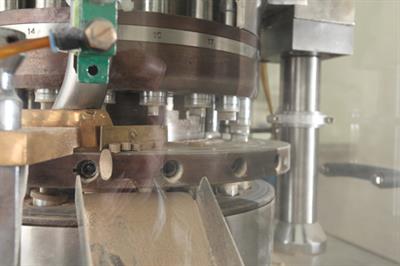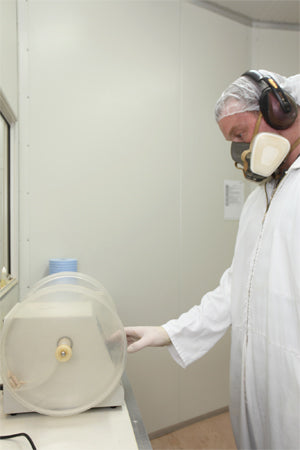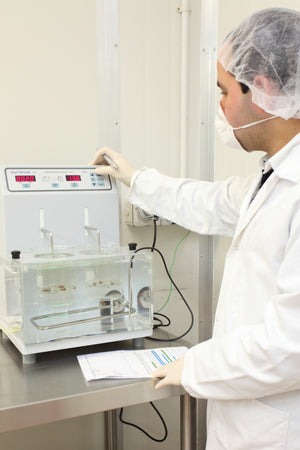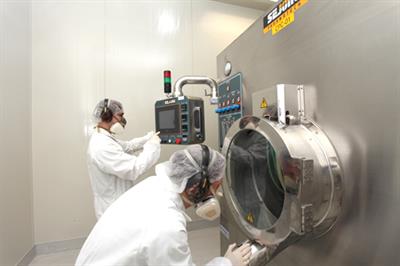OK, now we have to turn the blended powder into tablets. In some ways, this is a bit like baking a cake. They must disintegrate according to specifications detailed in the BP (British Pharmacopeia) and the tablets must not be too hard or too soft. This means monitoring closely as the tablets are being produced and constantly taking samples and testing them for hardness as the process goes on.
The tablet press has a series of 'molds' and the powder flows into the molds and then is pressed into the tablet shape.

Photo of the Tablet Shoot on the Tablet Press
As mentioned, we test for tablet hardness as they are being produced.

The Hardness Test
We also have to do what's called a 'friability' test which is done in a little tumbler machine to confirm that they won't break apart, particularly during the enteric coating process.

Friability Test
Samples of the tablets from each batch are kept as retention samples so that if we ever needed product from any batch for testing of any sort, they are available. The two tests above are carried out multiple times during the tableting of each batch.
After the batch has been tableted it is still not finished. However, before going to the next step we have to carry out another test which is disintegration. This confirms that that the tablets will disintegrate in the body and disperse the active ingredients. I am sure that you have heard stories about tablets passing through someone's body intact! That would never happen if the tablets passed this test. The results of all tests are fully documented.

Example of the Test Records
There are standards for disintegration set out by the US and British Pharmacopeia's which we adhere to. If the tablets do not pass this test (as is the case with other tests), they cannot be released and used.


Disintegration Equipment
The manufacturing process for our tablet products do not stop here. We then have to either put a pharmaceutical 'glaze' on them to make them easier to swallow or, in the case of many of our complex products we need to enteric coat them.
I am sure that most of our readers are familiar with the reasons why we enteric coat many of our tablets and that we are one of very few dietary supplement manufacturers in the world that do this. The reason is that we use a range of sophisticated and very expensive nutrients which are sensitive to stomach acid. The enteric coating protects these nutrients and enables them to be safely released into the upper intestine.
The coating process is carried out under controlled conditions in a special enclosed machine. It involves tumbling the tablets and spraying an aqueous solution on to the tablets with gentle heat that does not affect any of the ingredients. We use a special natural enteric coating solution which is clear. Although it looks the same as the other non-enteric coated tablets it is quite different.

Enteric Coating Process
One of the problems with the enteric coating process is that occasionally some tablets may break during the tumbling process. We remove any broken tablets during the bottling process, but sometimes the odd half-tablet sneaks through. We compensate for that possibility by setting the counter for an extra tablet just in case a half tablet was counted as one!
Remember the disintegration test? Well after doing the enteric coating we have to go through that process again. This time the tablets are tested in both acid and alkaline environments which simulate the conditions in the stomach and the upper intestine respectively. This is to ensure that the coating remains intact in the stomach but begins to breakdown efficiently in the upper intestine.
So, now we have finished producing the product in bulk form, but there is still more to go before we can ship it out to our customers. I will finish that part next week.


 Supplements
Supplements Superfoods
Superfoods Bundles
Bundles




